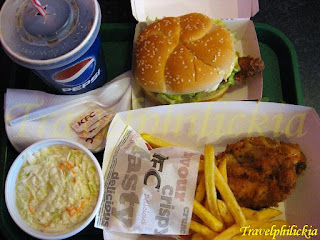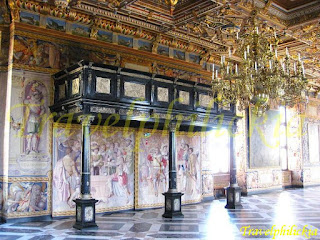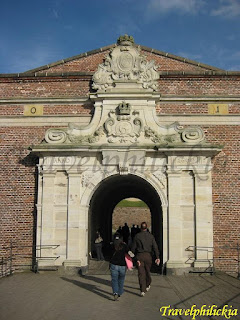After breakfast, we took Metro to 'Nørreport' Metro Station and walked towards the Botanical Garden.
Copenhagen Botanical Garden
Copenhagen Botanical Garden covers an area of 10 hectares and part of the Natural History Museum of Denmark. The Gardens have a total of 27 glasshouses and most notable is the 3000-m2 conservatory complex dating from 1874. The Palm House in the centre of the complex is 16-meters tall (photos below) and has narrow, cast-iron spiral stairs leading to a passageway at the top.

 National Gallery of Denmark
National Gallery of DenmarkNational Gallery of Denmark, or Statens Museum for Kunst in Danish, is a Danish national gallery (photos below) located besides the Botanical Gardens. The Museum has an impressive collection of almost 9,000 paintings and sculptures, approximately 240,000 works of art on paper as well as more than 2,600 plaster casts of figures from ancient, middle-ages and the Renaissance times.

 Rosenborg Castle
Rosenborg CastleRosenborg Castle, or Rosenborg Slot in Danish, was orininally built as a country summerhouse in 1606 by King Christian IV and has been expanded serveral times, finally evolving into its present condition by the year 1624 (photos below). Rosenborg Castle was used as a royal residence until around 1710. Visitors now can travel back in time and through the possessions of King Christian IV and his heirs get a sense of both everyday life and the festive aspects of royal life through 400 years.

 Bought our tickets which cost DKK 75 per adult and separate single ticket at DKK 20 for photography permit.
Bought our tickets which cost DKK 75 per adult and separate single ticket at DKK 20 for photography permit. Marble Room
- First room we visited on the ground floor was the Marble Room (photos below). The room was originally the bedroom of King Christian IV's wife, later King Frederik III had the room furnished in pompous Baroque style in 1668. The ceiling was given new stucco and the walls covered with imitation marble, which was much exclusive than real marble at that time.


- The Stone Corridor connects the two large gable rooms on the ground floor (photos below). Most of the items on display in the passage date from the time of King Christian IV, whose pedigree is seen in the middle of the corridor.


- King Christian VI's Room was originally the bedchamber of King Frederik IV's sister (photos below). The walls are now decorated with tapestries depicting scenes from the life of Alexander the Great. The exhibits in this room have a connection to King Christian VI.


- The Knight's Hall, located on the third floor, was completed in 1624 (photos below). Originally intended as a ballroom, the 'Long Hall' was used as Royal Reception Room for banquets in around 1700. It was not until second half of 19th century that it was known as the 'Knight's Hall'.

 Christian V had the hall partly modernised with twelve tapestries (left photo below) depicting the King's victories in the Scanian War (1675–1679). The stucco ceiling seen today is from the beginning of the 18th century. It shows the Danish Coat of Arms (right photo below) surrounded by the Orders of the Elephant and of Dannebrog.
Christian V had the hall partly modernised with twelve tapestries (left photo below) depicting the King's victories in the Scanian War (1675–1679). The stucco ceiling seen today is from the beginning of the 18th century. It shows the Danish Coat of Arms (right photo below) surrounded by the Orders of the Elephant and of Dannebrog. 

The main attractions of Rosenborg are the coronation chair of the absolutist kings and the throne of the queens (left photo below) with the three silver lions standing in front (right photo below).


One of the outstanding items is the Oldenburg Horn (photos below). The horn, made of silver and decorated with enamel in around 1465, was presumably a gift to the cathedral in Cologne from King Christian I during his visit to Rome in 1474 to 1475. After the reformation, it came back into the possession of the royal Danish house.


Set of emeralds and brilliants with diadem, necklace, brooch and earrings were on display (left photo below). The emeralds were originally a present from King Christian VI to Queen Sophie Magdalene in 1723. Jewellery set of gold with citrines, amethysts, pearls and diamonds belonged to Countess Danner (right photo below). It was probably a birthday present from King Frederik VII in around 1860.

 Highlight of the Treasury's collection is the crown of various kings and queens.
Highlight of the Treasury's collection is the crown of various kings and queens. King Christian IV's Crown
- Made between 1595 – 1596 with gold, enamel, table-cut stones and pearls, it has a total weight of 2.895 kg (left photo below). In the front of the crown, a pelican was seen pecking itself in order to feed its offspring with the blood (right photo below). This symbolized the need for every king to sacrifice his own blood in order to protect his subjects, as well as being a traditional representation of the devotion of Christs' sacrificial death.


- Made between 1670 – 1671 with gold, enamel and table-cut stones, it weighs a total of 2.080 kg (left photo below). This crown of the Absolute Monarchs was used by the kings from King Christian V to King Christian VIII. Two garnets, a spinel and a sapphire decorated the circlet of the crown. The front acanthus leaf is decorated with a large table cut diamond with King Christian V's royal monogram that is visible behind it (right photo below).


- All queens consort after Charlotte Amalie of Hesse-Kassel were crowned. Queen Sophia Magdalen of Brandenburg-Kulmbach, the queen of King Christian VI, did not want to use the crown worn by her predecessor and had a new crown made in 1731. This crown is made like that of King Christian V but only taller and slenderer (photos below). It is decorated with table cut diamonds that are assumed to come from the 1648 crown of Queen Sophie Amalie.




Lunch at a Fast-Food Restaurant
Took Metro to City Hall Square where we decided to have lunch in a fast-food restaurant. Ordered a 'Fully-loaded' meal at DKK 77 (left photo below). Curiously we saw a delivery van outside the restaurant with the fast-food chain logo painted as only black instead of the usual red/white color (right photo below). Not too sure if that was a new design.

 Hamlet Castle Tour
Hamlet Castle TourBooked this half-day tour from website few weeks prior to the trip. The duration of the tour was 5-hours and cost SGD 101.60 per person after currency conversion, which includes visits to Frederiksborg Castle, Fredensborg Palace and Kronborg Castle. All the three castles are located in Northern Zealand.
Soon after some confirmation on the tour group, the coach bus left the City Hall Square at 1315 hours. First sight was Frederiksborg Castle.
Frederiksborg Castle
Frederiksborg Castle is located in Hillerød, north of Copenhagen. This impressive and unrivalled Renaissance castle was built in the first centuries of the 17th century by the legendary Danish King Christian IV and incorporates the best of Renaissance architecture and craftmanship.
As the castle is built on an islet, visitors would need to walk a few minutes before reaching the main entrance (photos below).


The quadrangular castle is built of red brick with stepped gables, towering spires and light sandstone decorations. The castle is noted for its towers and turrets where all outer corners are decorated with towers (photos below).

 Neptune Fountain
Neptune Fountain- In the outer courtyard is the Neptune Fountain, built as a symbol of Denmark's status as the leading Baltic power during the early 17th Century (photos below). The sea god Neptune majestically rises above the fountain base which also features the famous goddess Fama amongst others.


The current fountain is a replica of the original water feature that was created in approximately 1617. The original statues were stolen by the Swedish troops during the Swedish Wars in 1659 and can be found today in the park at Drottningholm Castle.
The Rose
- Next, we got to visit the Castle's interior. The room on the ground floor in the King's Wing known as the Rose was originally a dining room for the king and his courtiers (photos below).


- The Audience Chamber (left photo below) was decorated in the 1680s combining the Renaissance style with Baroque, which makes this chamber the oldest preserved Baroque room in Denmark. It was fortunate that the Audience Chamber escaped from the fire in 1859. The ceiling in the Privy Passage (right photo below) was sumptuously decorated with flowering vines, creepers and rosettes.


The central dome bears the motto of Christian V: Pietate et Justitia or Piety and Justice (left photo below). Interestingly the chair in the north-east corner allowed the King to be lifted up from the building's entrance (right photo below).


- The Great Hall is situated above the Chapel and also extends over the length of the west wing. It was destroyed by fire in 1859 but was fully restored in 1880 where the segments of the ornate glided ceiling were preserved (photos below).

 The large chandelier in the centre of the room (left photo below) was the work of Carl Brummer while the original tapestries depicting important events in the life of Christian IV (right photo below).
The large chandelier in the centre of the room (left photo below) was the work of Carl Brummer while the original tapestries depicting important events in the life of Christian IV (right photo below).


Fredensborg Palace, or Fredensborg Slot in Danish is located on the eastern shore of Lake Esrum in Fredensborg. Do not confused with the other two of similar names: Frederiksberg Palace or Frederiksborg Castle. The beautiful 18th-century baroque palace was built as a hunting palace for King Frederik IV and is today the Danish Royal Family's spring and autumn residence, and is often the site of important state visits and events in the Royal Family (photos below).


It is the most used of the Royal Family's residences, thus we could only admire the Palace from the courtyard. Danish Royal Guards were seen marching in front of the palace (photos below).


Kronborg Castle and Fortification
Kronborg Castle, or Kongelige Slotte in Danish, is a castle and stronghold in the town of Helsingør. It is immortalized as Elsinore in William Shakespeare's play 'Hamlet' (photos below).


 |
Kronborg is one of the most important Renaissance castles in Northern Europe and was inscribed on the UNESCO's World Heritage List in 2000. |

 We left the castle after exploring its exterior.
We left the castle after exploring its exterior. Gefion Fountain
The Gefion Fountain, or Gefionspringvandet in Danish, is a large fountain on the harbour front in Copenhagen (left photo below). It features a large-scale group of oxen pulling a plow and being driven by the Norse goddess Gefjon. It is located next to the Kastellet.
Ivar Huitfeldt Column
The Ivar Huitfeldt Column is located close to the Gefion fountain (right photo below). It was built to commemorate the death of Admiral Ivar Huitfeldt and his men from HDMS Dannebroge, which exploded and sank in the Battle of Køge Bat during the Great Northern War. The monument was constructed in 1886.


The Little Mermaid (on vacation)
The Little Mermaid, or Den lille Havfrue in Danish, is a bronze statue depicting a mermaid becoming human based on the 1837 fairy tale of the same name by Danish author Hans Christian Andersen. The sculpture is displayed on a rock by the waterside at the promenade in Copenhagen. It is 1.25 metres tall and weighs 175 kilograms. It has been a major tourist attraction since its unveiling in 1913.
During our visit, the Copenhagen City Council had arranged to move the statue to Shanghai EXPO 2010 at Danish Pavilion from May till October (left photo below). This was the first time the statue had been removed officially since it was installed almost a century ago. Instead, a LED screen was placed at the original location to broadcast its live images from Shanghai (right photo below).


Amalienborg Palace
Amalienborg Palace is the home of the Danish Royal family. It consists of four identical classical palace façade with rococo interiors around an octagonal courtyard (left photo below). The equestrian statue of King Frederick V stood in the centre of the courtyard (right photo below).

 Amalienborg is guarded day and night by the Royal Life Guards, and we were again lucky to witness the post replacement in the evening (photos below). The post replacement is conducted every two hours.
Amalienborg is guarded day and night by the Royal Life Guards, and we were again lucky to witness the post replacement in the evening (photos below). The post replacement is conducted every two hours.

Dinner at Nyhavn
Decided to have dinner at Nyhavn. Sky turning dark at 8 pm in the evening and the restaurants at Hyhavn already lighted up (photos below).

 After some considerations, we decided to have dinner in this Italian restaurant (left photo below). Ordered a carbonara for myself, which cost a total of DKK 159.50 (including drinks and service charges). Taste was authentic but its portion seemed to be rather small for me.
After some considerations, we decided to have dinner in this Italian restaurant (left photo below). Ordered a carbonara for myself, which cost a total of DKK 159.50 (including drinks and service charges). Taste was authentic but its portion seemed to be rather small for me.

We went back to hotel for a good rest after dinner.
Day Three
After breakfast, we checked out from the hotel and took Metro to the Airport.
Had lunch at "Yam Yam to Go" in the airport (left photo below). Ordered a 'Green Thai Chicken Curry' at DKK 79 (right photo below). Definitely could not compare its taste with authentic Thai curry but it was only acceptable to be served as a quick bite in the airport.

 We reached Geneva Airport at about 2.30pm. As it was still early, we then decided to take a short visit in Geneva before taking train back to Neuchâtel.
We reached Geneva Airport at about 2.30pm. As it was still early, we then decided to take a short visit in Geneva before taking train back to Neuchâtel. With this, it ended our short weekend trip to Copenhagen.
 Posts RSS
Posts RSS


